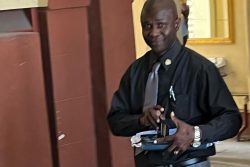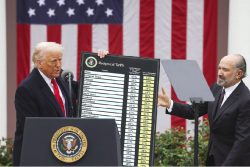While there is nothing in this country to compare with the two great risings of 1763 in Berbice and 1823 in Demerara, they were not the only ones to have taken place here.
 There are others about which not a great deal is known because they were very small scale and for the most part were put down with relative ease. One such is the rebellion involving only 26 people, which took place on the upper Berbice some months before Coffy and his fellow revolutionaries took up arms against the Dutch. It is of particular interest, because it may have showed the conspirators of the great uprising that conditions had changed, and revolt might have some hope of success.
There are others about which not a great deal is known because they were very small scale and for the most part were put down with relative ease. One such is the rebellion involving only 26 people, which took place on the upper Berbice some months before Coffy and his fellow revolutionaries took up arms against the Dutch. It is of particular interest, because it may have showed the conspirators of the great uprising that conditions had changed, and revolt might have some hope of success.
 The 1762 revolt occurred on the plantation of Goed Fortuin, which belonged to planter Laurens Kunckler, who was a Councillor of the Court of Policy. On July 3, 1762, Kunkcler left the enslaved Africans and Amerindians alone on his plantation to go and attend a meeting of the court at the Dutch headquarters of Fort Nassau downriver. Three days after he had sailed off in his tent boat, the men and women on Goed Fortuin under a leader named Adam, began the action to free themselves, embarking on this project in the conventional way by breaking open chests and cupboards in addition to a store-house.
The 1762 revolt occurred on the plantation of Goed Fortuin, which belonged to planter Laurens Kunckler, who was a Councillor of the Court of Policy. On July 3, 1762, Kunkcler left the enslaved Africans and Amerindians alone on his plantation to go and attend a meeting of the court at the Dutch headquarters of Fort Nassau downriver. Three days after he had sailed off in his tent boat, the men and women on Goed Fortuin under a leader named Adam, began the action to free themselves, embarking on this project in the conventional way by breaking open chests and cupboards in addition to a store-house.
 This raid on the plantation stocks yielded a good supply of flintlocks, ball and powder, among other things, because Kunckler was a militia captain, and had to keep weapons and ammunition in his home for times of crisis.
This raid on the plantation stocks yielded a good supply of flintlocks, ball and powder, among other things, because Kunckler was a militia captain, and had to keep weapons and ammunition in his home for times of crisis.
 Looking to their longer-term needs, the rebels slaughtered two cows, and then barbecued the meat to preserve it. According to one contemporary source, they also took an ample supply of bottles of wine. While tastes varied from one person to the next, every Dutch planter was well stocked with alcoholic beverages of one variety or another; it was thought impossible to survive the tropics without some fortification of this kind.
Looking to their longer-term needs, the rebels slaughtered two cows, and then barbecued the meat to preserve it. According to one contemporary source, they also took an ample supply of bottles of wine. While tastes varied from one person to the next, every Dutch planter was well stocked with alcoholic beverages of one variety or another; it was thought impossible to survive the tropics without some fortification of this kind.
Being of limited number, the rebels were not about to hang around to be wiped out by the Dutch; they needed somewhere relatively inaccessible where they could put up defences for their protection. They therefore loaded everything they had seized into three vessels, and then proceeded upriver, beating a drum as they went. The following year drums were to play an important part in communicating information about the great uprising from one plantation to the next, and perhaps on this occasion too the rebels were alerting the people on other estates and calling on them to join them.
As the group rowed upstream, they came across some Africans from a plantation called Goed Land owned by planter Perotet. These turned out to be reluctant recruits to the cause of rebellion, however, and nearly all of them managed to escape from the Goed Fortuin people shortly afterwards.
According to Dutch historian Ineke Velzing, the rebels were eventually to establish themselves high up the river on an island in a creek, which they fortified with bush they had cut down and presumably piled around the encampment. The initial expeditions (including some Indians) sent against them were not successful, and in fact
one of these, led by Lieutenant Thielen, sustained two dead and five wounded at the hands of the rebels.
It was at this point, according to Velzing, that the Dutch governor, Van Hoogenheim summoned the Indian captains – probably Arawaks – and asked them to arm their men with bows and arrows and assist the Dutch in wiping out the camp. Most of the Indians were unreceptive to his request because they knew the rebels were armed with firearms, and they had no intention of setting themselves up as cannon fodder.
Van Hoogenheim’s next idea, says Velzing, was to load three swivel guns into the fort canoe and then bombard the entrance of the creek. This task was given to Kunckler, but by this time the rebels had moved themselves much further upstream and when the Dutch in due course put in an appearance there they were met with another salvo.
Van Hoogenheim’s problem was that a mystery disease had seriously weakened the white population, and had hit the garrison at Fort Nassau particularly hard. He was in no position, therefore, to overpower even a small group of rebels. However, he calculated that it was now a month since they had rebelled, and they were probably beginning to feel the effects of hunger. He consequently set up a small post at the entrance to a creek, which was their only exit, and waited.
Velzing says that on August 8 or 9, hunger indeed caused them to attempt to break out, which gave the Dutch the opportunity of ambushing them. Some were killed, and after that the Amerindians eliminated most of the others in the bush. From two of the rebels who were captured – an Amerindian named Antoinette and an African named Coffy – the Dutch learned that the rebels’ firearms had ceased to function. Velzing recounts how Coffy told his captors that the leader Adam had instructed him (Coffy) to make a plan because of the defective weapons.
It is from an official at Fort Nassau that we have a contemporary account of what happened to Coffy of Goed Fortuin after his capture, but first he tells us a little about Adam. He had either been brought to Berbice when he was young, or else was a Creole born in the colony, because he was initially a houseboy for Kunckler. As a consequence of his “good services” in that capacity he had been made a bomba when he got older (‘bomba’ was the name for a driver in Berbice). Adam was not taken by the Dutch alive, and there was a suggestion he may have been killed by one of his comrades.
When Coffy was brought before the Court of Justice, we are told, “he played very dumb.” He appeared to understand no one, and no one could understand him, no matter which language they used to address him. When in jail, however, he would shout, “Adam, Adam,” but eventually, it seems, he stopped this and arrived at a point where he decided to confess. On November 22, 1762, he finally admitted to being a leader of the rebellion, among other things. He told the Dutch that before embarking on rebellion, the participants had taken what an official calls a “fetish drink” (probably a blood oath) on which they had sworn not to abandon each other. They had chosen Adam as their “chief” and he had promised them that if one of them were captured, he would set that person free in the night. This was the reason, he was alleged to have said, that he had been calling Adam’s name.
Not surprisingly, Coffy received a death sentence, about which, we are told, he was “cheerful.” Five days later he was notified that he would be executed on November 29.
On the appointed day he requested a glass of kilthum (a rudimentary form of rum), for which he had been asking ever since he was convicted by the court. The governor ordered that he now be given this, and while he drank it he was asked whether he did not wish that he hadn’t done what he did. He replied that it did not matter now, but where they had failed, others would succeed.
At 11 am, he was taken outside the fort to the place of execution, accompanied by soldiers beating a drum. He then had to endure the terrible end that was typical of the system and the era.
While the small 1762 rebellion appeared somewhat hare-brained in its conception, it allowed the conspirators (or perhaps potential conspirators at this stage) who were eventually to bring off the altogether more menacing rising a few months later to make certain useful observations about the possibilities for revolt.
The first was that the Dutch were weak, and did not have enough healthy soldiers at the fort to deal with a camp of 26 persons with dispatch. The second was that even the Amerindians on this occasion were not all that co-operative, while the Akawaios, as the Dutch later learnt, had even given the rebels something to eat. These two things opened up avenues for successful revolt, which were not normally available. When 1763 rolled around, Van Hoogenheim still had hardly any fit soldiers at his disposal to deal with any level of resistance, while many Amerindians had left Berbice because of the disease which was still ravaging the Dutch, but to which the Africans appeared to have some immunity.
The third thing that the 1763 conspirators might have noticed was that the firearms of the 1762 rebels had kept the Dutch at bay for quite some time. When they were eventually overcome it was because of non-functioning flintlocks in a situation where hunger had forced them into the open.
It was not a mistake that Coffy, Accara, Atta and the others of 1763 fame were to make; they drilled their troops in the use of firearms, and had the blacksmith from Fort Nassau – a revolutionary named Prins – repair them. In the early days, at least, Coffy of Lelienburg also attempted to address the matter of food supplies for a large body of people. He was unable to sustain it, however, and his successors made little if any effort to even try. Starvation, therefore, did play some role in the collapse of the 1763 uprising.
Finally, after the 1762 rebellion the conspirators of 1763 would have witnessed just how panicky the Dutch were; they had lost their psychological confidence so essential for the wielding of power. The events of 1762 set off rumours of rebellion up and down the colony, most of which were found to be groundless, but which in their turn spawned further rumours and anxiety among the whites. This too was a lesson surely not lost on the future leaders of 1763.








